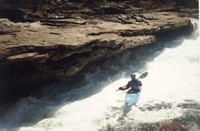Rivers are powerful, predictable and persistent
Rivers are filled with various obstacles. Many obstacles like holes, waves, and falls make the very rapids we find challenging and fun. Other obstacles like low head dams, sieves, undercuts, and strainers are features we really want to avoid. Scouting, either from the boat or on shore is one of the most important precautions we can take to avoid becoming another statistic. This article attempts to describe many of the river obstacles you may encounter on future river trips.
Many that are new to our sport grossly underestimate the power of water. It isn't unusual for a small stream to flow at 300 CFS. One CFS of water weighs 62.5 pounds. Since pins often occur where the river necks down, a very large portion of the stream's flow is pressing down on the trapped object. Over time, most boaters discover they need to work with the river instead of fighting a losing battle. The AW site's national river database: AW River DB is a great safety tool. It is color coordinated to let you know when your favorite streams are reasonably safe to paddle. River levels may also rise unexpectedly from isolated storms upstream. When paddling isolated runs, we need to pay attention to the overall river level and potentially take off the river when the level is too high for safe boating.
Hazards and Hydrology
 River reading is a crucial boating skill. These days, there is an unfortunate tendency of new boaters blindly following lead boaters down streams when they "Step It Up". If the lead boater flips or catches an eddy, those following lack the skills to determine their own path and this can be quite dangerous. A common trait of solid intermediates is the ability to break rapids down via eddy hopping. Never leave your present eddy until you see a clean path too your next eddy. If this is not possible, head to shore to shore scout. River reading takes time to master but certainly will keep you out of harm's way and make boating a great deal more fun.
River reading is a crucial boating skill. These days, there is an unfortunate tendency of new boaters blindly following lead boaters down streams when they "Step It Up". If the lead boater flips or catches an eddy, those following lack the skills to determine their own path and this can be quite dangerous. A common trait of solid intermediates is the ability to break rapids down via eddy hopping. Never leave your present eddy until you see a clean path too your next eddy. If this is not possible, head to shore to shore scout. River reading takes time to master but certainly will keep you out of harm's way and make boating a great deal more fun.
Page 4 of 4
